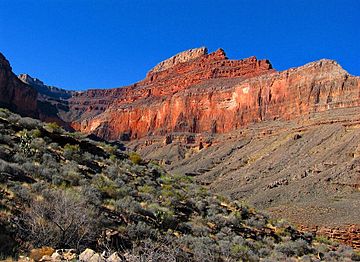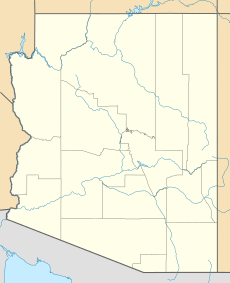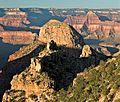Pollux Temple facts for kids
Quick facts for kids Pollux Temple |
|
|---|---|

Northeast aspect, from Tonto Trail
|
|
| Highest point | |
| Elevation | 6,251 ft (1,905 m) |
| Prominence | 762 ft (232 m) |
| Isolation | 1.91 mi (3.07 km) |
| Parent peak | Diana Temple (6,683 ft) |
| Geography | |
| Location | Grand Canyon National Park Coconino County, Arizona, US |
| Parent range | Coconino Plateau Colorado Plateau |
| Topo map | USGS Piute Point |
| Type of rock | limestone, sandstone, mudstone |
| Climbing | |
| First ascent | March 1969 by Alan Doty |
| Easiest route | class 4 climbing |
Pollux Temple is a 6,251-foot-elevation (1,905 meter) summit located in the Grand Canyon, in Coconino County of northern Arizona, USA. It is situated ten miles northwest of Grand Canyon Village, and less than one mile northeast of Jicarilla Point. Castor Temple is one mile northwest, and Diana Temple is one mile southeast. Topographic relief is significant as Pollux Temple rises nearly 4,000 feet (1,220 meters) above the Colorado River in less than two miles. Pollux Temple is named for Pollux, the divine son of Zeus according to Greek mythology. Clarence Dutton began the practice of naming geographical features in the Grand Canyon after mythological deities. According to the Köppen climate classification system, Pollux Temple is located in a Cold semi-arid climate zone.
Geology
The top of Pollux Temple is composed of Permian Toroweap Formation overlaying cream-colored, cliff-forming, Permian Coconino Sandstone. The sandstone, which is the third-youngest of the strata in the Grand Canyon, was deposited 265 million years ago as sand dunes. Below the Coconino Sandstone is reddish, slope-forming, Permian Hermit Formation, which in turn overlays the Pennsylvanian-Permian Supai Group. Further down are strata of the conspicuous cliff-forming Mississippian Redwall Limestone, the Cambrian Tonto Group, and finally granite of the Paleoproterozoic Vishnu Basement Rocks at river level in Granite Gorge. Precipitation runoff from Pollux Temple drains north to the Colorado River via Agate and Sapphire Canyons.
Gallery






